Table Of Contents
Quote Overview
Quote is a document that lists all the prices proposed by you to your customer for your products and services. In Workstair, you can create and send a quote and get approval from your customer instantly.
Create Quote
Learn how to create a Quotation:
- Goto Menu > Quotes
- Click the +New button in the top right corner of the page.
- or click Create New > Quotation under the utility button at the top right corner.
In the Customer details, Enter Customer information:

| 1a. | Customer: | Choose the customer to whom you will send this quote. You can choose an existing customer from the drop down list or create a new one by clicking the +New button(Complete the details of Customer and select save). |
| 1b. | Contact Person: | A person who represents the customer and with whom you conduct all work-related conversations. You can choose a contact person from the drop down list or add a new contact by clicking the +New button. A customer may have more than one contact person. Click here to learn how to add more than one contact person. |
| 1c. | Job Title: | A short description related to the service that you are going to deliver can be entered as a job title. |
| 1d. | Subject: | Add subject for the quote. In the above example quote subject is “Quote for building cleaning and AC Maintenance”. |
| 1e. | Introduction: | Provide a brief overview of your company, including key details and context that help the customer understand who you are and what your organization offers. Alternatively, you can load an introduction from pre-set templates. |
In the Quote details section, you can enter the following details:

| Reference: | The reference number, often known as the document number, is the unique number used to identify each Quote. You can create a default quote number pattern that will have a sequence number that is increased with each new quote. It is possible to edit and manually input this reference number. While clicking on the edit icon, an option Select Reference Pattern will show, which is to select a pattern which is already saved under Settings > Reference Pattern. |
| Job Type: | The job type can be either One-off or Recurring. Choose “One-off” if the service is needed just once and select “Recurring” if your proposal includes services that will be repeated on a regular schedule. Learn how to create a recurring quotation by clicking here. |
| Date: | The date of the quotation is commonly referred as the Quote date. The default date will be the current date, but you can also modify it. |
| Valid Until: | Choose a date till which the Quote is valid. The Quote validity period is the time period during which you commit not to raise any prices included in the quotation or change any component of the quotation. |
| Quoted By: | Choose the employee who represents this Quote on your company’s side. When the Quote is printed, the quoted by information can be displayed. |
| Payment Terms: | The number of days within which payment should be made after receiving the Invoice. You can manage payment terms under Company Setup > Company Profile > Manage Payment Terms. |
| Follow up after: | You are configuring the quotation follow-up reminder here. Once the quotation is submitted, a reminder will display in the dashboard after the specified number of days. The day counter will actually begin when the Quote status is changed to submitted. |
| Priority: | Priority is a simple priority labeling for the Quote that is used internally in your organization. The available options are Low, Medium, and High. |
| Group: | Choose a group to which this quote belongs. Any classification inside your organization can be considered a group. |
| Tax Exempt: | When you tick this checkbox, all tax-related values will be removed from each line item of the Quote. |
In the Items header section, you can enter the following details:

| Title: | The title for the scope of work. Check the Jobsite as Title checkbox to replace the title with the jobsite. This will not be printed by default in the Quote, but it can be used as a Variable within any content. |
| Jobsite: | Jobsite is the physical location where the work is done. You can choose a job site from the drop-down list. You can use the “jobsite variable” to display the jobsite anywhere in the quote content. Click here to know how to add multiple job sites for a Customer. |
| Scope of Work: | You can add your scope of work here in this field. The Scope of Work is the area in an agreement where the work to be performed is described and it may contain any milestones, reports, deliverables, and end products that are expected to be provided by you. |
In the line items section, you can enter the following details:
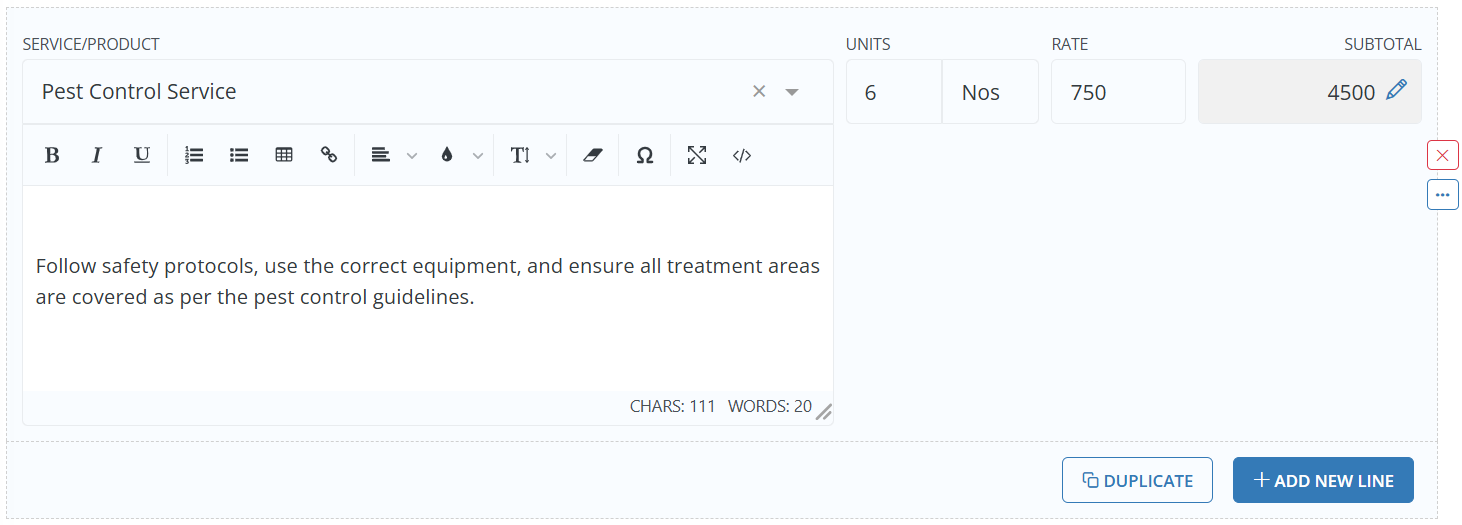
| Service/Product: | Choose the service or product from the drop-down list. You can add service items from a separate menu in the company setup; you cannot do so right here. Click here to know how to add new service/product. |
| Service Description: | Add your description about the service. It might be anything, such as details about the service, how it is used and supplied, and what all things clients will receive. |
| Units: | Add the number of units of services provided. |
| Unit Measurement: | Add the measuring unit, if needed. It depends on the service you offer. It could be Hours, Square feet, Square Meter, and so forth. |
| Rate: | It is the price per unit of the service. |
| Subtotal: | It is the unit price multiplied by the total unit. This field is also editable, and when you make changes, the unit rate is updated based on the total units. |
| Duplicate: | Clicking the duplicate button will add the same service item with the same quantity and price to the quote. |
| Add New Line: | Click this button to add a new service line item to the quote. |
In the bottom section, you can enter the following details:
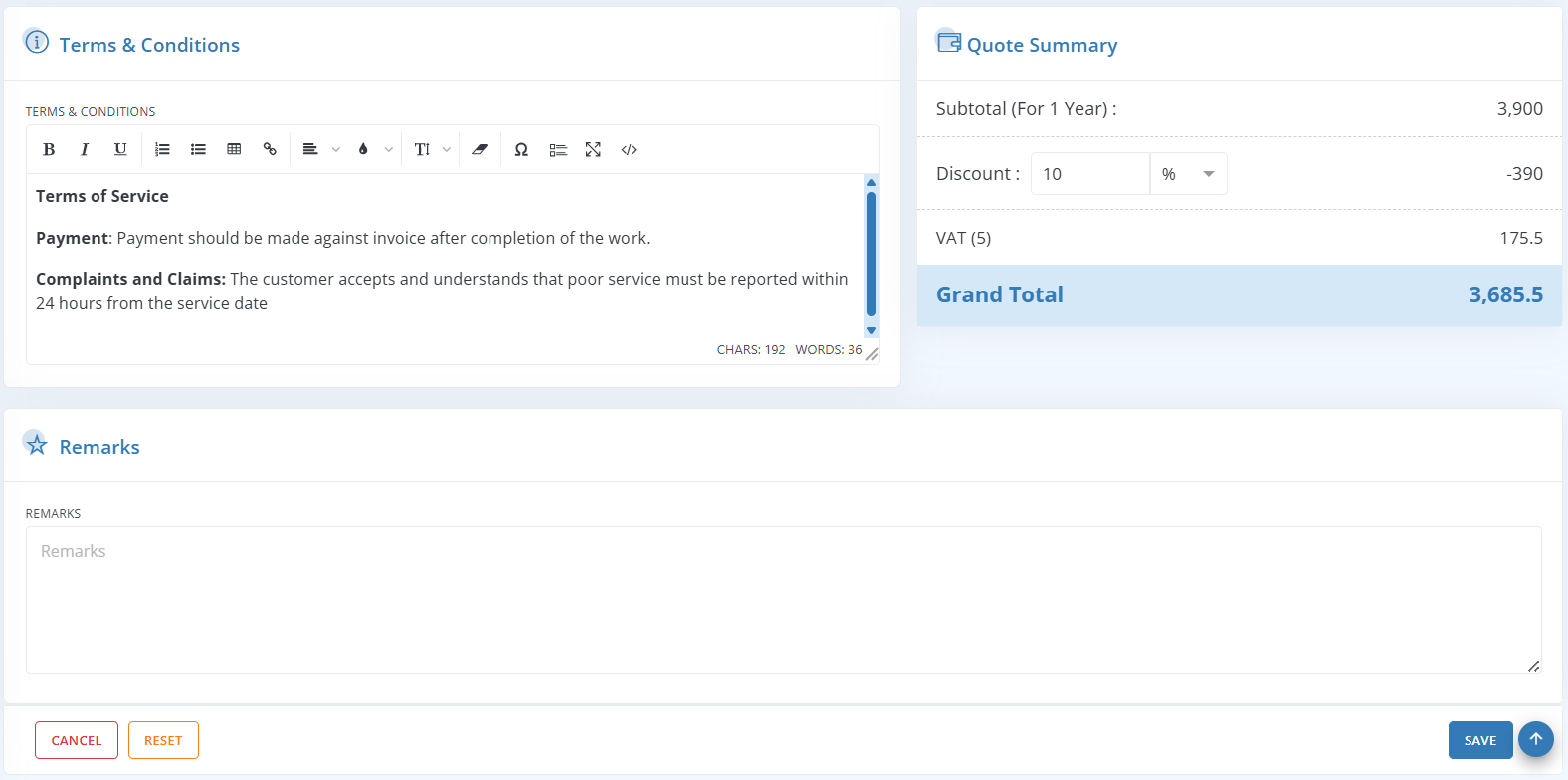
| Terms and Conditions: | Add terms and conditions to clarify things like payment terms, warranty terms or any other terms. |
| Subtotal: | Total of all quoted prices, without any discounts or taxes. |
| Discount: | You can add any discount on the entire Quote here in this Discount field. |
| Tax: | Total Tax amount in the quote. |
| Grand Total: | The final amount after everything is added up; the sum of other totals. |
| Remarks: | You can add any remarks on your quote. |
| Cancel: | Click Cancel to bring back to previous screen. |
| Reset: | Click Reset to cancel all the changes you made in the quote. |
| Save: | Click Save to save the quote and it will be in draft status. |
Add Optional Item
The Optional feature allows you to add any optional services to your Quotations. These services will be clearly labeled as Optional in the output and will not contribute to the Grand Total amount, providing clarity for your clients.
To enable the Optional Item feature:
- Navigate to Settings > PDF Configurations > Quotes.
- Under Common Configurations, enable Add Optional Item.

Once enabled, you’ll find the Optional module in the Edit Quote page. Here, you can add services as optional by checking the Optional checkbox. Services marked as optional will not be included in the Grand Total amount.

To customize the appearance of optional services:
- Go to Settings > PDF Configurations > Quotes.
- Under Common Configurations, adjust the background color, font color, and other settings.
- Click Save to apply your changes.

Below is an example of how the PDF output will look:
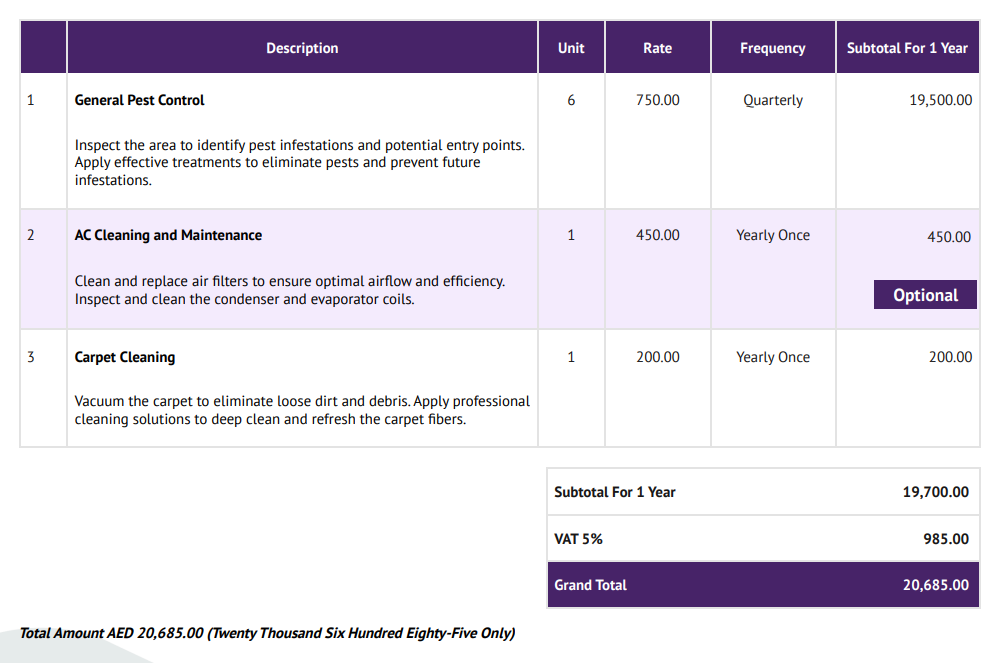
Additional Quote Configurations
The additional configuration button is found in the top right corner of the quotation editing page.
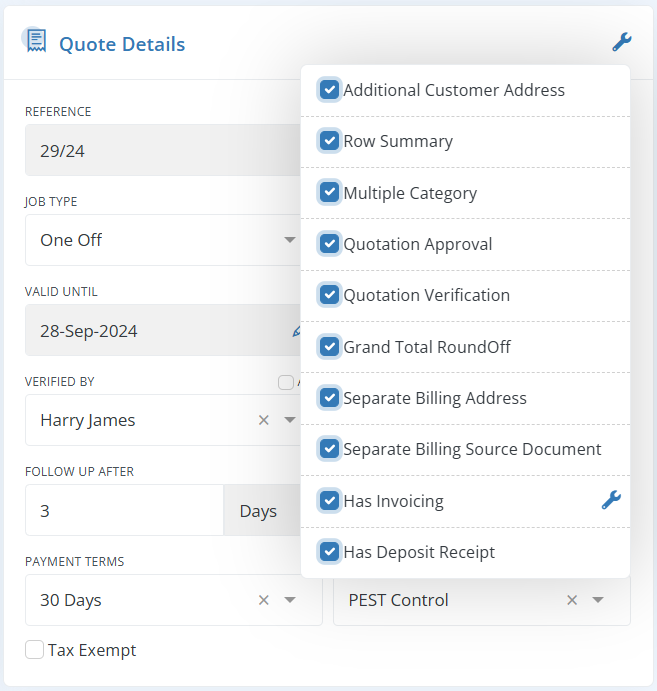
Additional Customer Address
- To add more than one Customer address, enable Additional Customer Address.
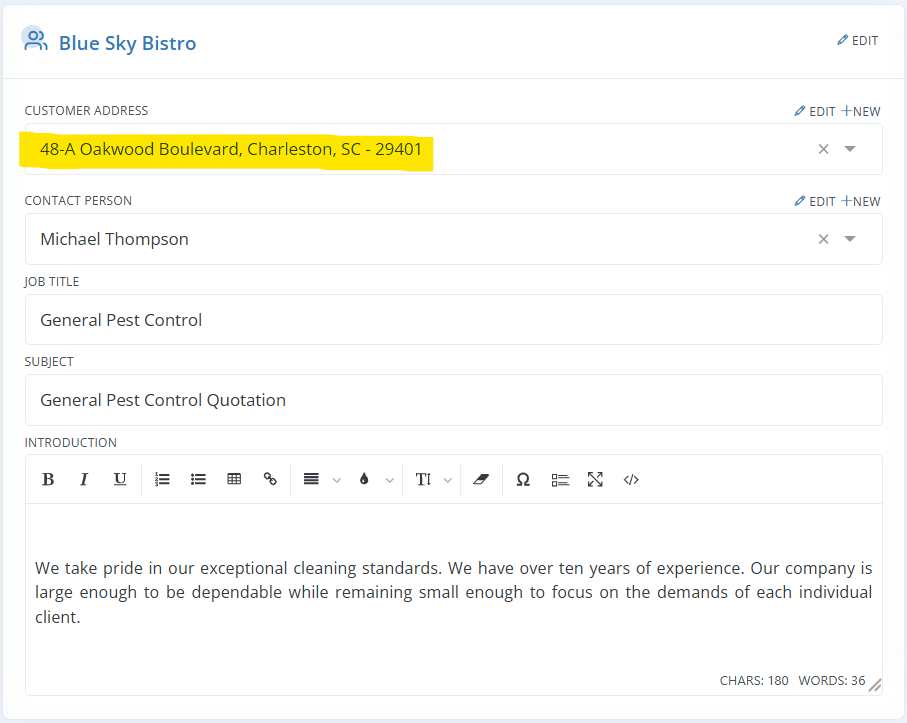
Row Summary
Enable Row Summary, to display Subtotal, Discount, Tax and Grand Total will display in the row itself.
| Subtotal: | Calculated as unit price multiplied by total units. This field is editable, and any changes will adjust the unit rate accordingly. |
| Discount: | Apply a Discount to the service item, if applicable. |
| Tax: | The Tax amount applied to the service item, which can be configured in Company Setup >Taxes |
| Grand Total: | The final amount after all additions, discounts, and taxes are applied |
- It is necessary to enable Row Summary if you want to add any discounts to the line item. Adding a discount is as simple as clicking the colored $ label.
- If the row summary is enabled, you can also add, change or remove taxes from the line item.

Multiple Category
You can add multiple categories within a single Contract. For instance, if you need to offer the same service at different job sites with varying prices, you can add multiple categories.
- Tick the Multiple Category checkbox to enable More Options and +Add Category at the bottom of the service line-item section
- Under More Options, you can choose to Duplicate, Insert, or Delete a category.

The output will finally look like this:

Quotation Approval and Verification
- Enable the Quotation Approval option to specify the person who reviewed and approved the Quote.
- Enable the Quotation Verification feature to confirm that the details in the Quote have been reviewed and validated by the designated person.
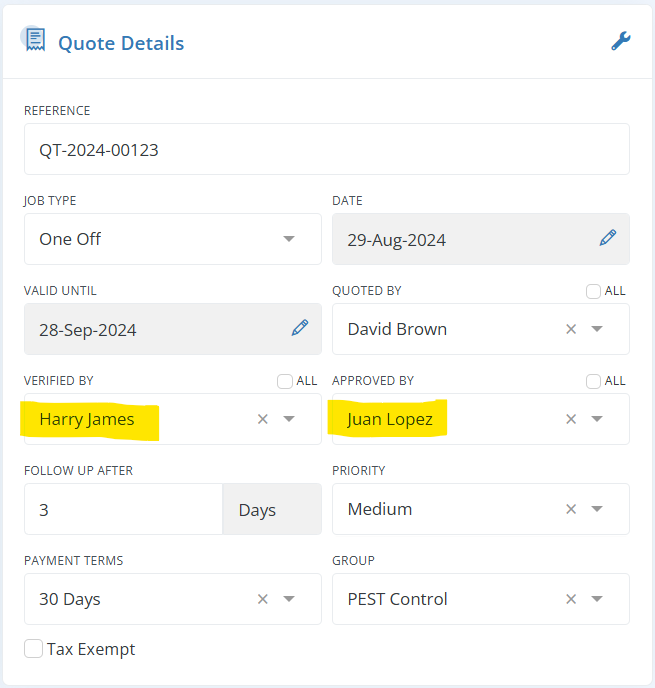
Grand Total RoundOff
Enable Grand total Round off to Round off the grand total value to the nearest lower or higher whole number.
For example: if the grand total is 1237.6 then it will round to 1238.
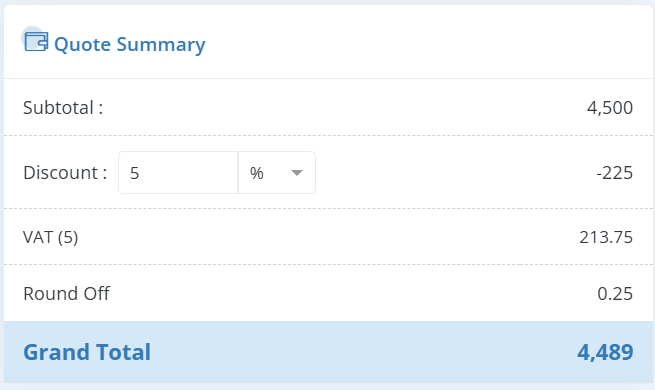
Separate Billing Address

| Billing Customer: | Choose the Billing Customer from the list. |
| Billing Contact Person: | Choose the Billing Contact Person from the dropdown list. To add a new billing contact person, click the +New button in the top right corner of this field. |
| Billing Customer Address: | Choose the Billing Customer Address from the dropdown list. |
Separate Billing Source Document
A Billing Source Document is a reference document, such as a Purchase Order (LPO), that provides essential details for billing purposes and helps ensure accuracy and consistency throughout the service workflow.
You have the option to include a Billing source document in the Quote, such as an LPO (Purchase Order). When adding the document, you can provide details like the Documented date, Document reference number, and Document name.

Once added, this Billing Source Document will automatically carry over across the entire workflow. Whether you convert the Quote to a Contract, create a Job, add Schedule Plans and Schedules, or ultimately generate an Invoice, the source document details will remain attached throughout each stage.
This functionality isn’t limited to Quotes alone—any document where you add a Billing Source Document will maintain those details across the entire cycle, ensuring consistency and traceability.

Has Invoicing
Enable Has Invoicing if you want to generate Invoices from the Quotation itself.

| Invoice Start Date: | Choose Invoice start date for invoice reminders from the calendar. |
| Invoice End Date: | Choose the invoice end date for invoice reminders from the calendar. |
| Billing Frequency: | Select the billing frequency here. Invoice reminders will be generated based on the frequency you set. The default selection will be not necessary. Choose one from the list: Daily, Weekly, Monthly, Yearly |
| Advance Invoice: | Enable to send the invoice reminder immediately after creating the Quote. |
| Invoice After All Job Closed: | Check the Invoice After All Closed checkbox to send reminder after closing all Jobs |
Invoice Reminders
Workstair allows you to setup Invoice Reminders from Quotes, if the quotation Has Invoicing.
- Enter the Invoice Start and End dates and setup the Billing Frequency.
- Billing frequencies can be of Daily, Weekly, Monthly, Yearly or you can setup Custom frequencies.
- To setup Custom frequency, choose an interval from the drop-down menu: Day, Week, Month or Year

For example, if you need the Billing Frequency to be the Last Day of Every Month: Choose Frequency as Month, Every as 1 Month, Select Type as Day of Month and choose the Last Day.



These reminders will then be appearing in the Dashboard accordingly. Clicking on a reminder will take you to the relevant Workstair page.
For example, Quotation that required Invoice will take you to those quotations which is yet to be invoiced.
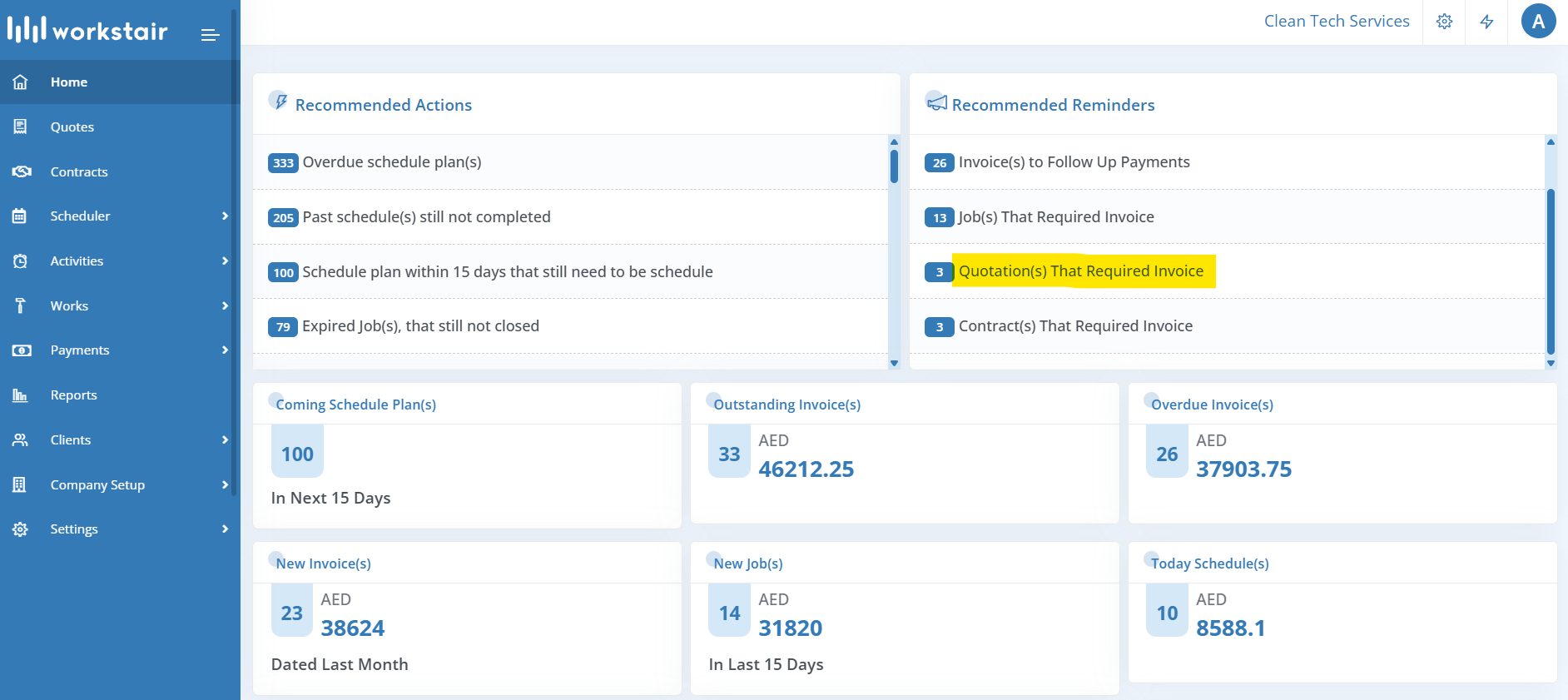
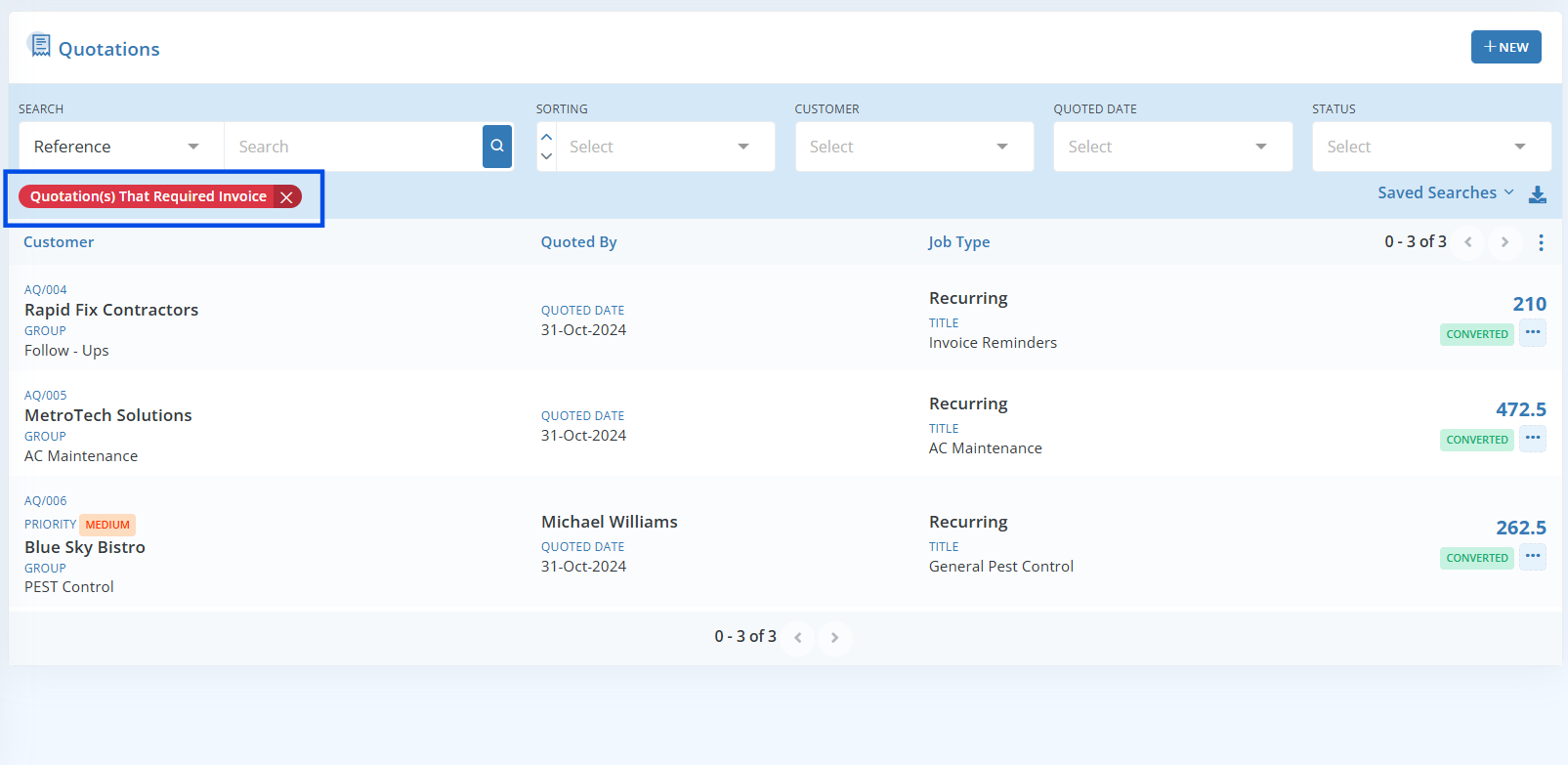
Advance Invoicing
In Workstair, Advance Invoicing lets you set invoice amounts in Quotes. You can specify initial, subsequent, and completion amounts for jobs. This feature gives you flexibility to set amounts per item, choosing fixed amounts or percentages.
Here are the steps to set up advance invoicing in a Quote:
- On the Quote Edit page, enable Has Invoicing under Configuration Settings.

2. Enable Advance Invoice and Invoice after all jobs closed in the Invoice Reminder section.
Note: If you want to set a specific amount for the first invoice only, enable ‘Advance Invoice’. If you need to set a specific amount after all jobs are completed, enable ‘Invoice After All Job Closed.’

3. Click the More button in the Service Item section, then select Invoice Configuration.

4. In the pop-up window, configure the following settings:
- Invoicing Type: Choose between Percentage or Amount.
- Invoicing: Set the normal invoicing amount to be generated.
- Advance Invoice: Specify the initial invoice amount.
- After All Jobs Closed: Set the invoiced amount after all Jobs are completed. This amount will be included in the Invoice only when all the Jobs from the Quote are completed.

Note: You can set different percentages or amounts for each item.
With these settings, Invoices created from Quotes will follow your setup automatically.
Recurring Quote
Consider the following scenario:
We are creating a recurring Quote for a one-year job with Four schedules that repeat in every 3 months.
In the Quote Details section:
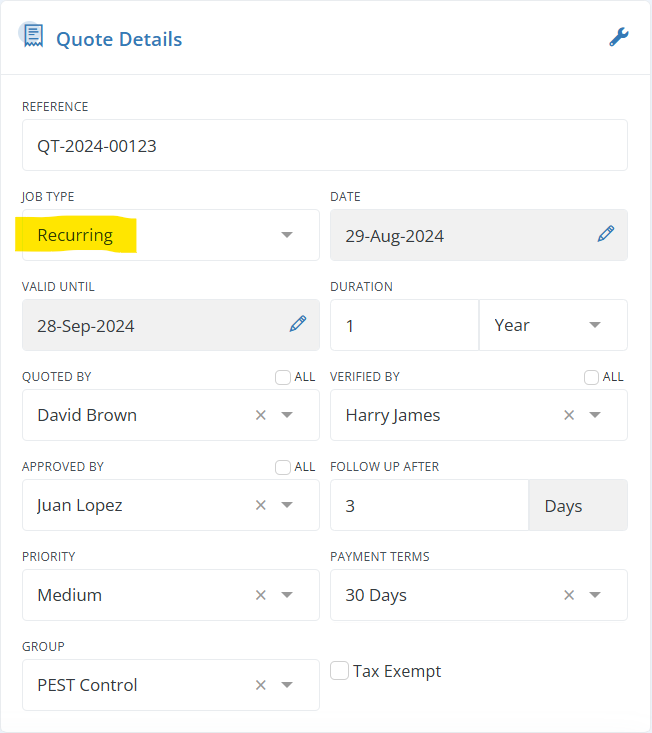
- Select Job type as Recurring
- Set any duration by adjusting the number field and changing the time span to Year, Month, Week, or Day
In Service/Product Item section:

| Frequency: | Enter the Frequency. Tick Every checkbox, to set the Schedule frequency for “Every given time duration”. |
| Summary: | Total units will get adjusted in accordance with duration and frequency. The Subtotal will be adjusted in accordance with the frequency selection. |
The output of example will finally look like this:

More options in line item
The basics of service items, including how to add a service item, change the quantity, and set a pricing, have been covered in this section.
On the service line-item area, go to the far-right corner for additional options button, then click to view the options as shown below.

| Duplicate: | Click Duplicate to add an identical service item to the Quote. (Use this option when you want to add a similar service item with a few minor changes.) | |
| Insert Item Above: | Adds a line item above this line item. It is used to bring a service item above the existing item in the linear order. |
Once you select Set Item Name, Set Frequency Term and Adjust Total Units, Then Service/Product pane will appear like this.

| Set Item Name: | Adds an alternate name for the service line item. If an alternative name is specified, the actual service item name will be replaced with the given name. |
| Set Frequency Term: | The given custom frequency term will replace the default frequency term (system generated) in the PDF document. For example, you can give “Quarterly” for any service that is provided for “Every 3 months”. |
| Adjust Total Units: | It is used when you want to change the number of service units in the system-calculated units. The Subtotal price will be recalculated when you adjust the total units. |
Quoted By Signature
To enable quoted by Signature in Workstair is quite easy.
- Go to Settings > PDF Configurations
- Select Quotes from the dropdown

- In the Common Configurations, enable the Signature module
- Customize the Signature label and Font size
- Click Save to apply the changes

Note: Ensure the employee with Signature is selected as the Quoted By contact.
More Actions
You can perform a number of actions once a Quote is created. These actions are available in the action pane of the Quote summary page.
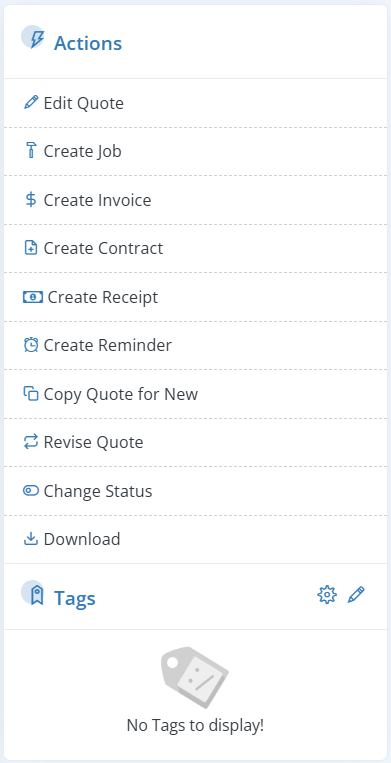
| Edit Quote: | You can edit and modify an existing Quote. |
| Create Job: | Generate a Job from a Quote. Customer details and service items will be transferred to the Job upon conversion. However, once a Quote is converted to a Job, any changes made to the Quote will not reflect on the Job. |
| Create Invoice: | Create an Invoice directly from a Quote. All service items, along with unit and pricing information, customer details (name, address, and contact), and job-related information (job type and duration), will be transferred when a Quote is converted to an Invoice. |
| Create Contract: | This option is used to convert a Quote into a Contract. All service items, unit and pricing information, customer details (name, address, and contact), and job-related details (job type and duration) will be transferred to the Contract. |
| Create Receipt: | Generate a Receipt from a Quote. Customer details and payment amount will be carried over from the Quote to the Receipt. |
| Create Reminder: | You can create Invoice Reminders directly from the Quotes. |
| Copy Quote for new: | Create a new Quote by duplicating an existing one. All details will be copied except for the Quote number and date. |
| Revise Quote: | You can Revise an existing Quote. The revised version will retain the same Quote number with an “R” suffix. |
| Change Status: | Update the status of a Quote. For example, once a Quote is submitted to the customer, you can change its status from Draft to Submitted. |
| Download: | This button is used to download the saved Quote to share it with the client. |
Quote Statuses
| Draft: | This is a quote which is simply created but not sent to the client. |
| Submitted: | This is a quote already submitted and waiting for a response from the client. |
| Request to modify: | This is a quote that a client requested you to change something. |
| Approved: | This is a quote that has been approved by the client. |
| Converted: | This is a quote that converted to job. |
| Revised: | This is a revised Quote. |
| Rejected: | This is a quote rejected by a client. |
| Archived: | A quote which is not converted to a job can be kept as archived. |
Using Variables
In Workstair, a variable represents a generic value in a textual portion of a document that will be replaced with an actual value when the output is generated. In document templates, you can add a variety of variables, such as the quoted date, the jobsite, the job duration, etc. These variables will be replaced with actual values in the outputs when you generate PDF. To choose a variable, click the drop-down menu in the text box’s right corner.
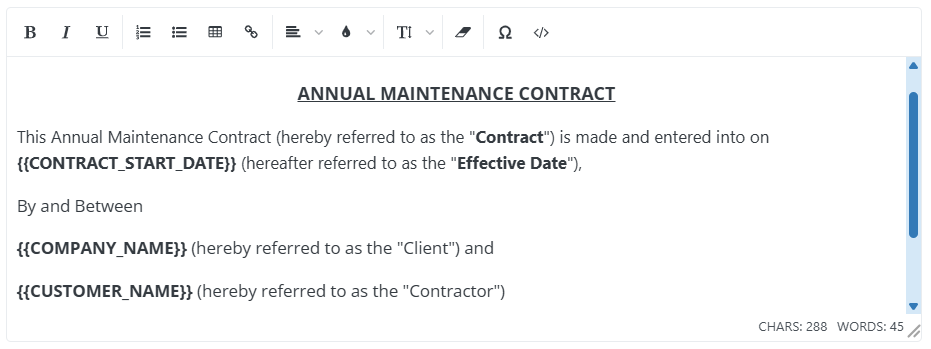
The output will be:

Some examples of available variables are:
- Current date
- Job site
- Customer group name
- Contract end date
- Delivery note reference
- Company name
- Contact Person name
- Quote date
- Contract grand total amount in words
- Contract grand total amount in words
- First schedule start date
- Company address
Quote Templates
Certain sections of the Quote, such as the “Introduction,” “Scope of Work,” and “Terms and Conditions,” are frequently repeated for similar services. These repetitive sections can be saved as Quote Templates in Workstair, allowing you to create quotations quickly and efficiently.
Note: Want to learn more about creating Module Templates ? Click here!

Introduction text will be added to the Quote after selecting an option from the list and clicking the Select button.
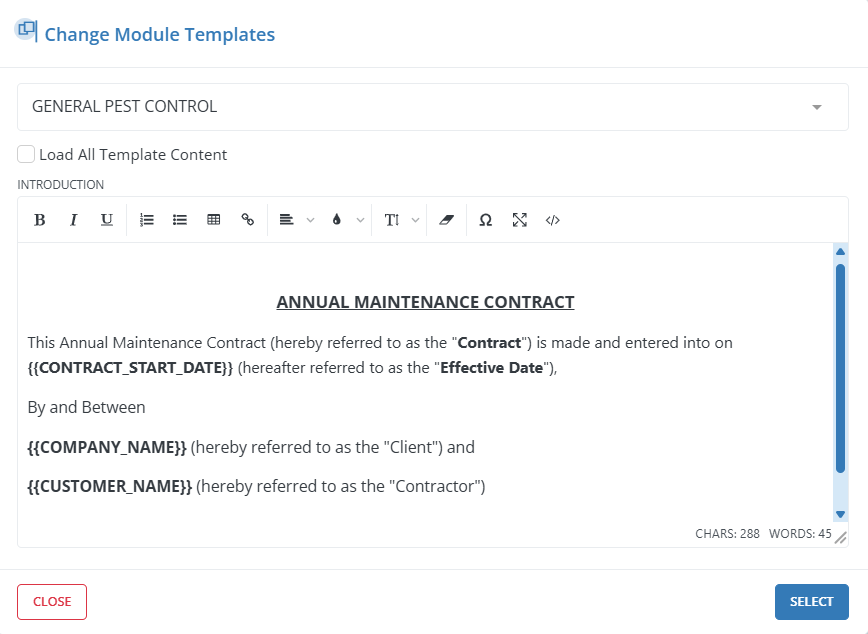
Load All Template Content
When the “Load All Template Content” checkbox is enabled, the sections for “Introduction,” “Scope of Work,” and “Terms and Conditions” will appear simultaneously.
Click the Select button to insert the content into the Quote.

Searching a Quote
The advanced search option in Workstair allows you to search documents in many ways.
To Search a Quotation in workstair:
- Goto Left Menu bar > Quotes
- Search Quotation by Job Title, Reference Number, Customer, Created Date or Status.
Note: To sort Quotes, select from available criteria such as Reference, Created At, Updated At, or Priority.

For more search options:
- Click Untitled Filter button.
- There you can search Quotes for multiple Customers, Job Sites, Tags, Statuses.
- Click Search
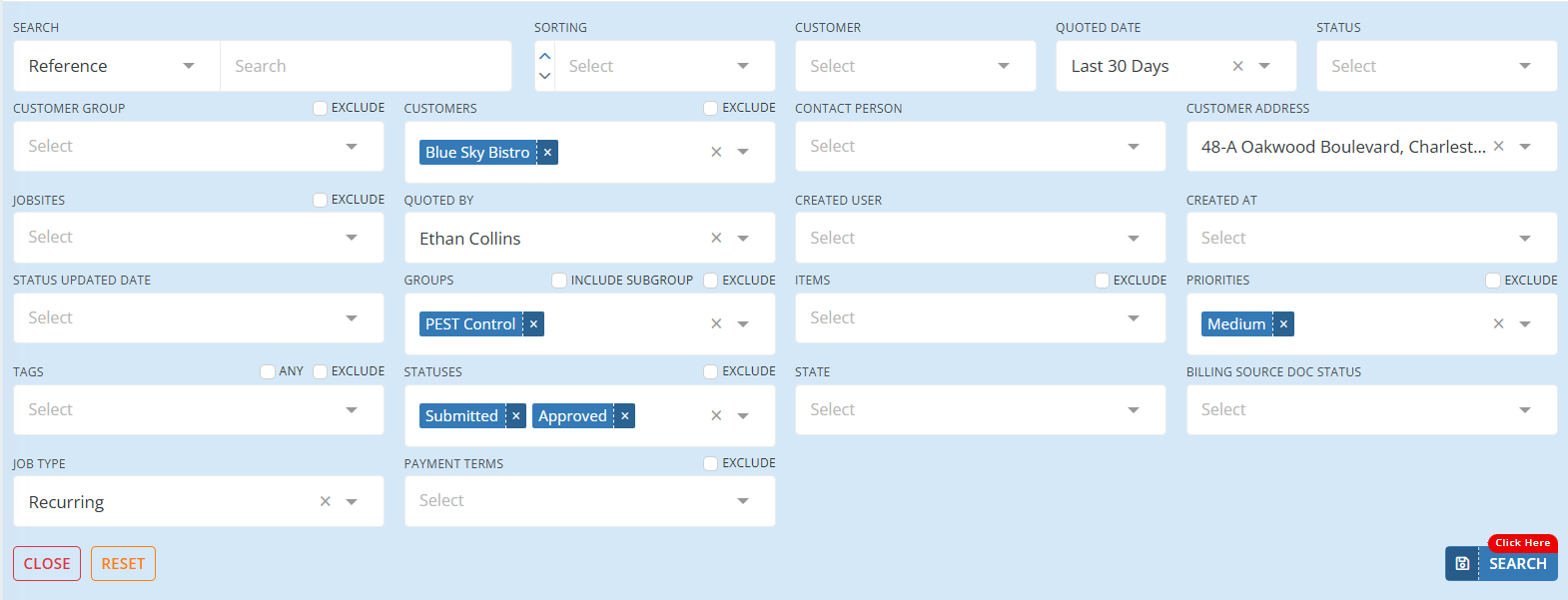
It is possible Later, when you click on the saved search, Quotes will be displayed based on the saved criteria. Click here to learn more about Saved Searches!

